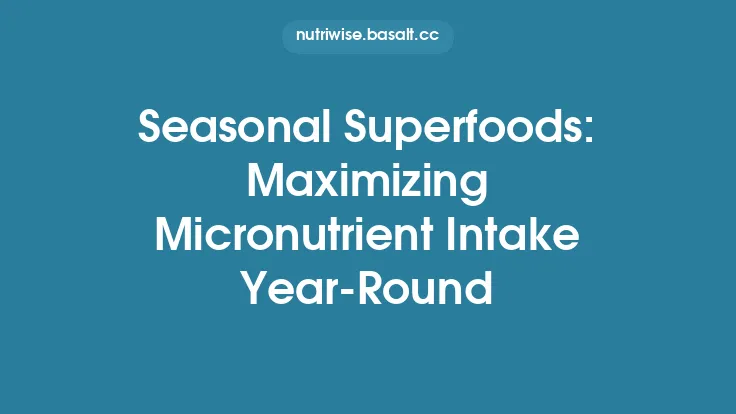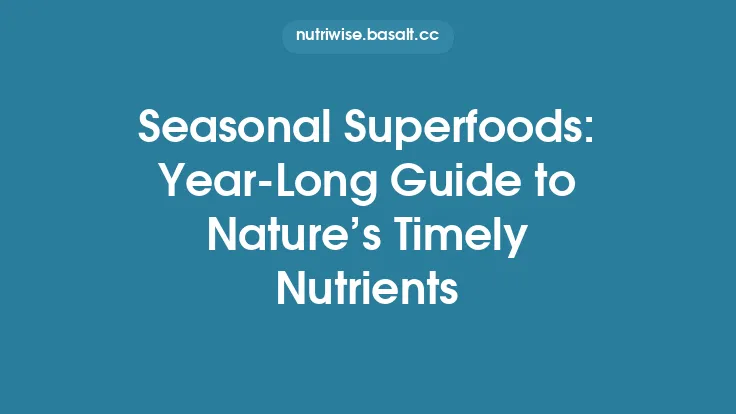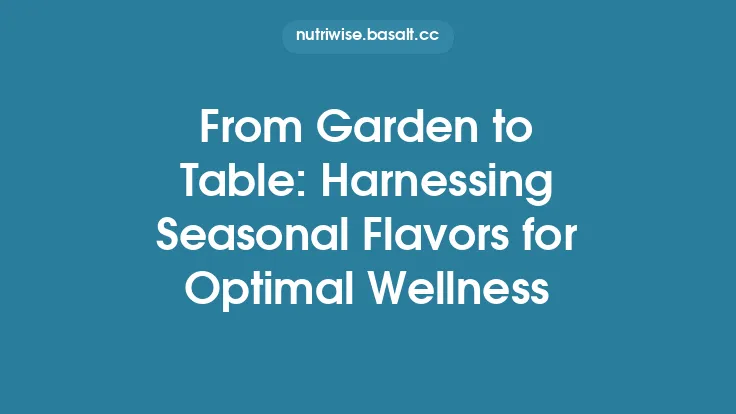Spring awakens the garden with a burst of tender greens, crisp shoots, and delicate blossoms that are not only a feast for the eyes but also a powerhouse of nutrients. By aligning our plates with what nature offers at each turn of the year, we tap into foods at their peak phytochemical concentration, ensuring maximum bioavailability of vitamins, minerals, and protective compounds. This article walks you through the most nutrient‑dense “superfoods” each season provides, explains why they matter, and offers detailed, health‑focused recipes that can be woven into any culinary repertoire.
Why Seasonal Superfoods Matter
Nutrient density at its highest
Plants synthesize their defensive chemicals—flavonoids, carotenoids, glucosinolates, and more—in response to environmental stressors such as sunlight, temperature fluctuations, and pest pressure. When harvested at the moment of peak ripeness, these compounds are present in concentrations far greater than those of out‑of‑season produce that has been stored for weeks or months. The result is a food that delivers more vitamins (A, C, K, folate), minerals (potassium, magnesium, iron), and phytonutrients per gram.
Enhanced bioavailability
Seasonal produce often contains optimal ratios of water, fiber, and natural sugars, which aid in the absorption of fat‑soluble vitamins (A, D, E, K) and other micronutrients. For example, the bright orange hue of early‑summer carrots signals high beta‑carotene levels, which are more readily converted to vitamin A when the vegetable is fresh.
Ecological and economic benefits
Choosing foods that are in season reduces the carbon footprint associated with long‑distance transportation and artificial ripening. Moreover, local markets typically price in‑season items more affordably, allowing you to incorporate a wider variety of nutrient‑rich foods without breaking the budget.
Synergistic health effects
When multiple superfoods are combined in a single dish, their bioactive compounds can act synergistically. The combination of vitamin C‑rich strawberries with iron‑rich spinach, for instance, markedly improves non‑heme iron absorption—a principle that can be leveraged in recipe design.
Spring Superfoods and Nutrient‑Rich Recipes
Key Spring Superfoods
- Asparagus – rich in folate, vitamin K, and the antioxidant glutathione.
- Ramps (wild leeks) – high in sulfur‑containing compounds that support detoxification.
- Pea shoots & young peas – excellent sources of plant‑based protein, vitamin C, and lutein.
- Strawberries – packed with anthocyanins, vitamin C, and manganese.
- Rhubarb – provides calcium, vitamin K, and soluble fiber.
Recipe: Asparagus‑Strawberry Quinoa Salad
Servings: 4
Nutrients per serving: ~350 kcal, 12 g protein, 8 g fiber, 15 % DV vitamin C, 30 % DV folate.
Ingredients
- 1 cup quinoa, rinsed
- 2 cups water
- 1 lb fresh asparagus, trimmed and cut into 1‑inch pieces
- 1 cup sliced strawberries, halved
- ¼ cup toasted almond slivers
- 2 tbsp extra‑virgin olive oil
- 1 tbsp lemon zest
- 2 tbsp freshly squeezed lemon juice
- 1 tsp Dijon mustard
- Salt and pepper to taste
- Optional: 2 tbsp crumbled feta for added calcium
Method
- Cook quinoa: Bring water to a boil, add quinoa, reduce to a simmer, cover, and cook 15 minutes. Fluff with a fork and let cool.
- Blanch asparagus: Submerge asparagus pieces in boiling water for 2 minutes, then shock in ice water to preserve color and crunch.
- Emulsify dressing: Whisk olive oil, lemon zest, lemon juice, Dijon mustard, salt, and pepper until smooth.
- Assemble: In a large bowl, combine quinoa, asparagus, strawberries, and almonds. Drizzle dressing, toss gently, and top with feta if desired.
- Serve: This salad can be enjoyed warm, at room temperature, or chilled—making it versatile for lunchboxes or picnics.
Why it works
The combination of vitamin C from strawberries and folate from asparagus enhances the absorption of iron present in quinoa. The healthy fats from olive oil improve the uptake of fat‑soluble antioxidants, while the fiber from almond slivers supports gut health.
Summer Superfoods and Nutrient‑Rich Recipes
Key Summer Superfoods
- Blueberries – high in anthocyanins and vitamin K.
- Heirloom tomatoes – abundant lycopene, potassium, and vitamin C.
- Sweet corn – provides resistant starch, B‑vitamins, and lutein.
- Watermelon – offers citrulline, a precursor to nitric oxide, supporting vascular health.
- Edamame – a complete plant protein source with isoflavones.
Recipe: Heirloom Tomato & Edamame Gazpacho
Servings: 6
Nutrients per serving: ~180 kcal, 9 g protein, 5 g fiber, 25 % DV vitamin C, 20 % DV potassium.
Ingredients
- 2 lb heirloom tomatoes, coarsely chopped
- 1 cup shelled edamame (cooked and cooled)
- ½ cup cucumber, peeled and diced
- ¼ cup red bell pepper, diced
- 2 tbsp red wine vinegar
- 2 tbsp extra‑virgin olive oil
- 1 clove garlic, minced
- ½ tsp smoked paprika
- ¼ tsp sea salt
- Fresh basil leaves for garnish
- Optional: ¼ tsp chili flakes for a subtle heat
Method
- Blend base: In a high‑speed blender, combine tomatoes, cucumber, bell pepper, garlic, and vinegar. Blend until smooth.
- Incorporate edamame: Add edamame, olive oil, smoked paprika, and salt. Pulse a few times to keep some texture.
- Adjust consistency: If the gazpacho is too thick, thin with cold water or ice cubes to desired texture.
- Chill: Refrigerate for at least 30 minutes to allow flavors to meld.
- Serve: Ladle into bowls, garnish with basil leaves and a drizzle of olive oil. Pair with a slice of whole‑grain toast for added complex carbs.
Why it works
Lycopene’s antioxidant activity is enhanced by the presence of healthy fats from olive oil. Edamame contributes all essential amino acids, making this cold soup a balanced source of protein and micronutrients, perfect for hot summer days when heavy meals are less appealing.
Autumn Superfoods and Nutrient‑Rich Recipes
Key Autumn Superfoods
- Kale – dense in vitamin K, vitamin C, calcium, and glucosinolates.
- Butternut squash – high in beta‑carotene, potassium, and dietary fiber.
- Pomegranate – rich in polyphenols, vitamin C, and iron.
- Chestnuts – provide complex carbohydrates, vitamin C, and manganese.
- Persimmons – abundant in beta‑carotene, vitamin A, and dietary fiber.
Recipe: Roasted Kale & Butternut Squash Power Bowl
Servings: 4
Nutrients per serving: ~420 kcal, 14 g protein, 12 g fiber, 150 % DV vitamin A, 80 % DV vitamin K.
Ingredients
- 1 medium butternut squash, peeled and cubed (≈3 cups)
- 2 tbsp coconut oil, melted
- 1 tsp ground cumin
- ½ tsp smoked paprika
- 4 cups kale leaves, stems removed and torn
- 1 cup cooked quinoa (or brown rice for variation)
- ½ cup pomegranate arils
- ¼ cup toasted pumpkin seeds
- 2 tbsp tahini
- 1 tbsp apple cider vinegar
- 1 tbsp maple syrup
- Salt and pepper to taste
Method
- Roast squash: Preheat oven to 400 °F (200 °C). Toss squash cubes with 1 tbsp coconut oil, cumin, smoked paprika, salt, and pepper. Spread on a baking sheet and roast 25‑30 minutes, turning halfway, until caramelized.
- Crisp kale: Toss kale with remaining 1 tbsp coconut oil, a pinch of salt, and roast for 8‑10 minutes, until edges are crisp but leaves remain tender.
- Prepare dressing: Whisk tahini, apple cider vinegar, maple syrup, and a splash of water to achieve a pourable consistency. Season with salt.
- Assemble bowl: In each serving bowl, layer quinoa, roasted squash, kale, pomegranate arils, and pumpkin seeds. Drizzle with tahini dressing.
- Enjoy: This bowl offers a balanced mix of complex carbs, plant protein, and a spectrum of micronutrients ideal for post‑harvest energy needs.
Why it works
The fat‑soluble beta‑carotene in butternut squash is better absorbed when paired with the healthy fats in coconut oil and tahini. Kale’s glucosinolates, known for supporting phase‑II detoxification enzymes, are preserved through gentle roasting, providing a potent antioxidant boost.
Winter Superfoods and Nutrient‑Rich Recipes
Key Winter Superfoods
- Brussels sprouts – high in vitamin C, vitamin K, and sulforaphane.
- Citrus fruits (blood oranges, grapefruits) – abundant in vitamin C, flavanones, and potassium.
- Root vegetables (beets, carrots, parsnips) – rich in beta‑carotene, nitrates, and fiber.
- Kohlrabi – provides vitamin C, potassium, and glucosinolates.
- Seaweed (nori, wakame) – a source of iodine, omega‑3 fatty acids, and unique polysaccharides.
Recipe: Citrus‑Glazed Brussels Sprouts with Beet‑Carrot Slaw
Servings: 5
Nutrients per serving: ~310 kcal, 8 g protein, 9 g fiber, 120 % DV vitamin C, 70 % DV folate.
Ingredients
- 1 ½ lb Brussels sprouts, trimmed and halved
- 2 tbsp avocado oil
- 1 tbsp honey (or agave for vegan)
- 2 tbsp freshly squeezed blood orange juice
- 1 tsp grated orange zest
- ½ tsp ground ginger
- Salt and pepper to taste
*Slaw*
- 2 medium beets, peeled and grated
- 2 large carrots, peeled and grated
- ¼ cup chopped fresh parsley
- 1 tbsp apple cider vinegar
- 1 tbsp extra‑virgin olive oil
- 1 tsp mustard seeds
- Pinch of sea salt
Method
- Roast Brussels sprouts: Preheat oven to 425 °F (220 °C). Toss sprouts with avocado oil, salt, and pepper. Spread on a sheet and roast 20 minutes, shaking halfway.
- Prepare glaze: In a small saucepan, combine honey, blood orange juice, orange zest, and ginger. Simmer for 2‑3 minutes until slightly thickened.
- Glaze sprouts: Remove Brussels sprouts from oven, drizzle glaze over them, and toss to coat. Return to oven for an additional 5 minutes to caramelize.
- Make slaw: In a large bowl, combine grated beets, carrots, parsley, apple cider vinegar, olive oil, mustard seeds, and salt. Mix thoroughly.
- Plate: Serve glazed Brussels sprouts atop a bed of beet‑carrot slaw. Garnish with extra orange zest if desired.
Why it works
The vitamin C from blood orange enhances iron absorption from the leafy sprouts, while the nitrates in beets support vascular dilation. The combination of warm roasted vegetables and cool, raw slaw offers a textural contrast that encourages mindful eating and satiety.
Integrating Seasonal Superfoods into a Balanced Meal Plan
- Macro‑micronutrient harmony
- Pair carbohydrate‑rich superfoods (e.g., sweet corn, butternut squash) with protein sources (edamame, quinoa, legumes) and a modest amount of healthy fats (olive oil, nuts) to stabilize blood glucose and promote nutrient uptake.
- Color‑coded nutrient mapping
- Aim for at least three distinct color families per day: deep greens (kale, Brussels sprouts) for lutein and chlorophyll; vibrant reds/oranges (beets, carrots, strawberries) for beta‑carotene and anthoc‑anthocyanins; and bright yellows/purples (citrus, blueberries) for flavonoids and vitamin C. This visual strategy ensures a broad spectrum of phytonutrients.
- Portion timing
- Schedule higher‑fiber, lower‑glycemic superfoods (root vegetables, legumes) for lunch to sustain afternoon energy, while lighter, water‑rich options (cucumber, watermelon) are ideal for dinner to support digestion and sleep quality.
- Seasonal batch cooking
- Roast a large tray of winter root vegetables or summer corn on the cob, then portion into freezer‑safe containers. This preserves nutrient integrity while providing quick, ready‑to‑use components for future meals.
Practical Tips for Sourcing and Preparing Seasonal Superfoods
- Farmers’ markets & CSAs: Directly purchasing from growers reduces the time between harvest and plate, preserving delicate antioxidants that degrade over prolonged storage.
- Organic vs. conventional: While both can be nutritious, organic produce often contains higher levels of certain polyphenols, especially in crops like kale and strawberries.
- Minimal processing: Whenever possible, consume superfoods raw or lightly cooked (steaming, quick sauté) to retain heat‑sensitive vitamins such as vitamin C and folate.
- Use of culinary tools: A high‑speed blender preserves the fiber matrix in smoothies and soups, while a mandoline slicer ensures uniform thickness for even roasting, which is crucial for consistent nutrient retention.
- Seasonal preservation: For periods when a favorite superfood is out of season, consider flash‑freezing at peak ripeness. This method locks in most vitamins and phytonutrients, allowing you to enjoy “off‑season” nutrition without compromising quality.
Conclusion: Harnessing the Power of Seasonal Nutrition
By aligning our meals with the natural rhythm of the earth, we not only savor the freshest flavors but also unlock the full nutritional potential of nature’s superfoods. Each season offers a distinct palette of micronutrient‑dense ingredients—spring’s tender greens, summer’s vibrant berries, autumn’s hearty roots, and winter’s robust crucifers. Through thoughtfully crafted recipes that respect the chemistry of these foods, we can build meals that support immune resilience, metabolic health, and long‑term vitality. Embrace the seasonal cycle, experiment with the recipes above, and let the ever‑changing bounty of the garden become the cornerstone of a thriving, nutrient‑rich lifestyle.





